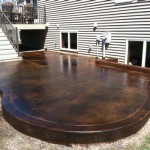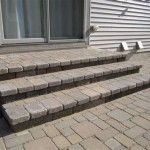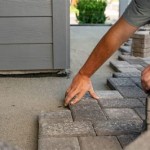Creating A Beautiful Concrete Patio With Paintings And Tiles
Concrete patios, often perceived as utilitarian surfaces, possess the potential to be transformed into vibrant and aesthetically pleasing outdoor living spaces. By thoughtfully incorporating paintings and tiles, it is possible to elevate the appearance of a concrete patio, creating a personalized and visually engaging environment for relaxation and entertainment. This article provides a guide to integrating artistic elements into concrete patios, highlighting the key considerations and techniques involved.
The transformation of a concrete patio using paintings and tiles necessitates preliminary planning. This stage involves assessing the existing patio's condition, defining the desired aesthetic, and selecting appropriate materials that withstand the rigors of outdoor environments. Ignoring these initial steps can result in premature deterioration of the applied artwork or inconsistent visual appeal.
The existing concrete surface must be thoroughly inspected for cracks, unevenness, or pre-existing coatings. These imperfections require remediation before any painting or tiling work can commence. Cracks, even minor ones, can expand due to temperature fluctuations and moisture penetration, causing any superimposed artwork to crack or flake. Unevenness can lead to tiling issues and an unappealing visual texture. Furthermore, prior coatings, such as sealants, may inhibit the adhesion of new paints or adhesives.
The chosen aesthetic should be aligned with the overall style of the house and the surrounding landscape. Consider the color palette, patterns, and themes that will complement the existing architectural elements and outdoor furniture. A cohesive design will enhance the overall aesthetic appeal and create a sense of harmony. Selecting paints and tiles specifically designed for outdoor use is crucial. These materials are formulated to resist fading from ultraviolet (UV) radiation, withstand water exposure, and endure temperature changes. Using interior-grade paints or tiles on an outdoor patio will lead to premature degradation and require frequent replacements.
Surface Preparation: The Foundation of Longevity
Proper surface preparation is paramount to the success of any painting or tiling project on a concrete patio. This involves cleaning, repairing, and priming the concrete to ensure optimal adhesion and durability of the applied artwork. Skipping or inadequately performing any of these steps can compromise the final result and necessitate costly repairs in the future.
The first step in surface preparation is thorough cleaning. This can be achieved using a pressure washer to remove dirt, debris, algae, and any loose particles. For stubborn stains, a concrete cleaner or degreaser may be required. It is crucial to rinse the surface thoroughly after cleaning to remove any residual cleaning agents, which can interfere with paint or adhesive bonding. Allow the concrete to dry completely before proceeding to the next step.
Any cracks or imperfections should be repaired using a concrete patching compound. Follow the manufacturer's instructions carefully to ensure proper application and curing. Allow the patching compound to dry completely and sand it smooth to create a seamless surface. Consider applying a concrete resurfacer for patios with extensive damage to create a new even surface. This product is applied as a slurry and troweled to a smooth finish.
Priming the concrete is essential for promoting adhesion and preventing the paint or adhesive from being absorbed into the porous concrete. Use a concrete primer specifically designed for exterior use. Apply the primer evenly and allow it to dry completely before proceeding to the painting or tiling stage. The primer forms a bond between the concrete and the applied material, which can significantly extend the lifespan of the artwork and tiling.
Painted Concrete Patios: Techniques and Considerations
Painting a concrete patio offers a cost-effective and versatile way to add color and personality to the outdoor space. Various techniques can be employed, ranging from simple solid colors to intricate murals and stenciled designs. Careful consideration must be given to the type of paint used, the application method, and the sealer applied to protect the artwork.
Acrylic concrete paints are generally recommended for exterior use due to their durability, UV resistance, and ease of application. Epoxy paints offer superior durability and resistance to chemicals, but they require more specialized application techniques. Choose a paint that is specifically designed for concrete surfaces and is resistant to fading, chipping, and cracking. Avoid using conventional house paints, as they are not formulated to withstand the harsh conditions of an outdoor environment.
Applying the paint can be done using a brush, roller, or sprayer. For large areas, a roller or sprayer is more efficient. For intricate designs, brushes and stencils provide greater control and precision. When using a brush or roller, apply thin, even coats of paint to avoid drips and runs. Allow each coat to dry completely before applying the next. If using a sprayer, follow the manufacturer's instructions carefully to ensure proper coverage and prevent overspray.
Sealing the painted concrete is crucial for protecting the artwork from the elements and extending its lifespan. Use a clear, penetrating concrete sealer specifically designed for exterior use. Apply the sealer evenly and allow it to dry completely. Reapply the sealer periodically, as recommended by the manufacturer, to maintain the protection and vibrancy of the painted surface.
Tiled Concrete Patios: Design and Installation
Tiling a concrete patio offers a durable and aesthetically pleasing alternative to painting. Tiles provide a wide range of design possibilities, allowing for the creation of intricate patterns, borders, and focal points. Careful consideration must be given to the type of tile used, the adhesive, and the grout to ensure a long-lasting and visually appealing result.
Porcelain tiles are generally recommended for outdoor patios due to their durability, water resistance, and frost resistance. Ceramic tiles can be used in milder climates, but they are more susceptible to cracking in freezing temperatures. Stone tiles, such as slate or travertine, offer a natural and elegant look, but they require more maintenance and sealing. Choose a tile that is specifically designed for exterior use and is slip-resistant, especially in wet conditions.
Using a high-quality modified thin-set mortar specifically designed for exterior use is essential. This type of mortar provides a strong bond between the tile and the concrete and is resistant to moisture and temperature changes. Follow the manufacturer's instructions carefully to ensure proper mixing and application. Use a notched trowel to apply the mortar evenly to the concrete surface, creating ridges that will grip the tile.
Grouting is crucial for filling the gaps between the tiles and preventing water penetration. Use a sanded grout specifically designed for exterior use. This type of grout is more resistant to cracking and shrinking than unsanded grout. Follow the manufacturer's instructions carefully to ensure proper mixing and application. Apply the grout evenly to the tile surface, filling all the gaps completely. Remove excess grout with a damp sponge and allow the grout to cure completely before sealing.
Integrating Paintings and Tiles: A Synergistic Approach
Combining paintings and tiles on a concrete patio can create a unique and visually striking design. This approach allows for the incorporation of both artistic expression and durable materials, resulting in a patio that is both beautiful and functional. There are several ways to integrate paintings and tiles, depending on the desired aesthetic and the skill level of the artist and installer.
One approach is to create a tiled border around a painted central area. This can be achieved by painting a large mural on the concrete surface and then framing it with a decorative tile border. The border protects the edges of the painted area and adds visual interest. Alternatively, small tiled accents can be incorporated into a painted design, such as tile mosaics or geometric patterns.
Another approach is to use painted tiles as individual elements within a larger tiled design. This can be achieved by painting individual tiles with different designs and then arranging them randomly or in a pattern within the overall tiled surface. This method allows for a great degree of customization and creative expression.
Consider using stencils to create repeating patterns with paint on tiled surfaces. After the grout cures and sealing the grout, Stencil the pattern with exterior grade acrylic paints. After the paint dries, seal it with an exterior concrete sealant to protect it from the elements.
Before commencing any painting or tiling project, it is crucial to create a detailed design plan that outlines the placement of the paintings and tiles, the colors and patterns to be used, and the overall aesthetic goal. This plan will serve as a guide throughout the project and ensure a cohesive and visually appealing final result.

How To Create Faux Tile Look On Concrete Patio Southern Hospitality

How To Create Faux Tile Look On Concrete Patio Southern Hospitality

Backyard Makeover How To Paint Concrete Look Like Oversize Pavers A House Full Of Sunshine
:max_bytes(150000):strip_icc()/faux-painted-rug2-5d0d2b1a8ddd4c60a39ffd329840874e.jpg?strip=all)
19 Painted Concrete Patio Designs
Elsie S Painted Patio Tiles A Beautiful Mess
:max_bytes(150000):strip_icc()/HomeIdeologypatio-90780b59737a4935b1e853e2b397f3f1.jpg?strip=all)
19 Painted Concrete Patio Designs

10 Painted Concrete Patio Floor Ideas So Much Better With Age

Before And After Painted Concrete Patio Thistlewood Farm

Backyard Makeover How To Paint Concrete Look Like Oversize Pavers A House Full Of Sunshine

How To Create Faux Tile Look On Concrete Patio Southern Hospitality
Related Posts








